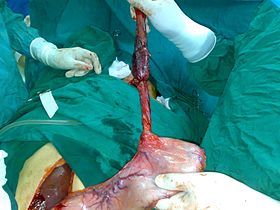Esophagectomy
| Esophagectomy | |
|---|---|
| Intervention | |

Surgical removal of the esophagus.
|
|
| ICD-9-CM | 42.40 |
| MeSH | D016629 |
Esophagectomy (US English) or Oesophagectomy (British English) is the surgical removal of all or part of the esophagus.
The principal objective is to remove the esophagus, a part of the gastrointestinal tract ("food pipe"). This procedure is usually done for patients with esophageal cancer. It is normally done to remove cancerous tumors from the body. It is normally done when esophageal cancer is detected early, before it has spread to other parts of the body. Esophagectomy of early stage cancer represents much the best chance of a cure. Despite significant improvements in technique and postoperative care, the long-term survival for esophageal cancer is still poor. Currently multimodality treatment is needed (chemotherapy and radiation therapy) for advanced tumors. Esophagectomy is also occasionally performed for benign disease such as esophageal atresia in children, achalasia, or caustic injury.
In those who have had an esophagectomy for cancer, omentoplasty appears to improve outcomes.
There are two main types of esophagectomy.
In most cases, the stomach is transplanted into the neck and the stomach takes the place originally occupied by the esophagus. In some cases, the removed esophagus is replaced by another hollow structure, such as the patient's colon.
Another option which is slowly becoming available is minimally invasive surgery (MIS) which is performed laparoscopically and thoracoscopically.
After surgery, patients may have trouble with a regular diet and may have to consume softer foods, avoid liquids at meals, and stay upright for 1–3 hours after eating. Dysphagia is common and patients are encouraged to chew foods very well or grind their food. Patients may complain of substernal pain that resolves by sipping fluids or regurgitating food. Reflux-type symptoms can be severe, including intolerance to acidic foods and large, fatty meals. Jejunal feeding tubes may be placed during surgery to provide a temporary route of nutrition until oral eating resumes.
...
Wikipedia
